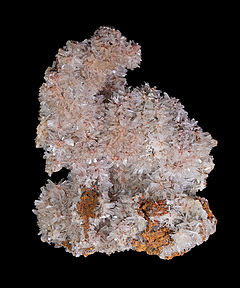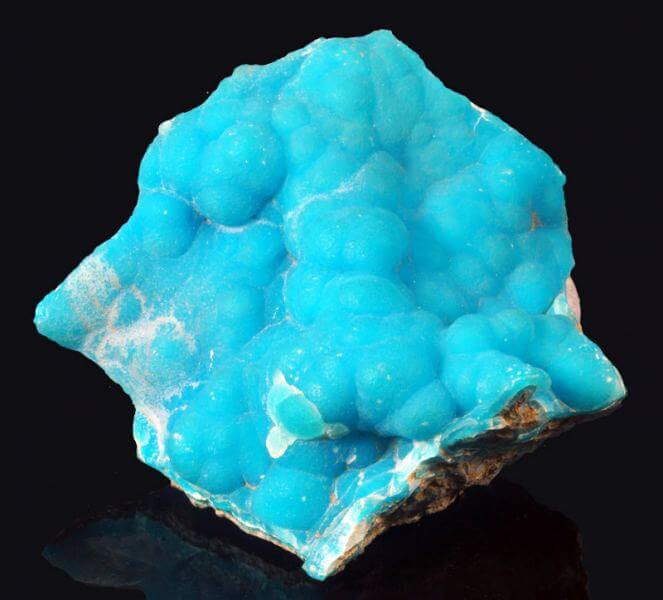Minerals to be tested for zinc should be treated along with carbonate of soda on charcoal, before the blowpipe. The presence of the metal is known by the incrustation on the charcoal (very luminous when strongly heated) which is when hot, yellow ; when cold, white. If the incrustation be moistened with nitrate of cobalt and heated, a fine green colour results. Before B.F., the metal is not obtained.
Calamine—(carbonate of zinc)
This is the most important ore. Massive, stalactitic, and not quite transparent.
- Colour—when pure, pearly white ; but owing to presence of iron oxide, generally brownish, sometimes green.
- Streak—whitish.
- Lustre—pearly or glassy.
- Structure—brittle.
- H.-5 ; S.G-.—3·3 to 3·5.
When pure, contains 52 per cent, of zinc ; the rest, oxide of iron, carbonate of line, and magnesia, &c.
Infusible alone before the blowpipe. Like other carbonates, effervesces in acid. Sometimes looks like calc spar.
Zinc Blende (sulphide of Zinc, Black Jack or marmatite)
- Massive and fibrous; crystallizes in octahedrons and dodecahedrons.

- Colour—when pure, yellow and transparent, but more usually, brownish red, garnet red, or blackish and translucent.
- Streak—white to reddish brown.
- Lustre—waxy.
- H.—3·5 to 4 ; S.G.—4.
- Some specimens become electric.
- Contains nearly 67 per cent, zinc : the rest sulphur.
Only fusible on the edges when heated alone on the blowpipe. Dissolves in nitric acid. If roasted in a glass tube, some of the sulphur is given off and a residue, zinc sulphate (white vitriol), is left. Occurs with iron and copper pyrites, silver ores, &c. Soluble in hydrochloric or citric acid.
Silicate of Zinc (zinc glance)
- Colour—whitish, blue, brown, or green.

- Not quite transparente
- Streak—whitish.
- Lustre—pearly or glassy.
- H.—4·5 to 5 ; S.G.—3·3 to 3·5.
- Contains about 53 per cent, of zinc ; the rest silica.
Before B.F. froths up and gives a phosphorescent light. Is fusible alone. With borax, yields a clear bead. If heated in sulphuric acid it dissolves, and the solution becomes gelatinous when cool : also in citric acid.
Red Zinc Ore
- Granular or massive.
- Cleavage—brittle slices, rather like mica.
- Colour—bright red.
- Streak—orange yellow.
- Lustre—brilliant.
- Not quite transparent.
- H.—4 to 4·5 ; S.G.—5·4 to 5·6.
- Contains about 80 per cent. zinc.

Infusible alone before the blowpipe. With borax, yields a transparent yellow glass. Sol. in nitric or boiling citric acid.
The principal ore, calamine, occurs in veins, beds, and pockets, usually in limestone of Devonian, Carboniferous, or Oolitic age. Zinc blende is found in the limestones of Great Britain and elsewhere. It is often associated with several metals in a lode. In Cornwall there is a saying, “ Black Jack rides a good horse ; ” that is, where zinc blende is met with at the top of a lode, copper may probably be met with deeper down.
